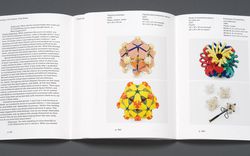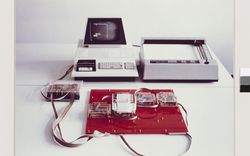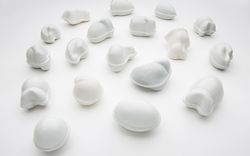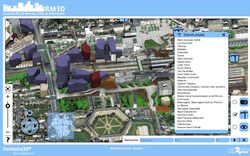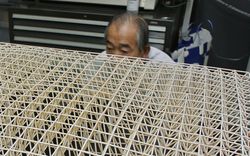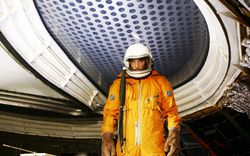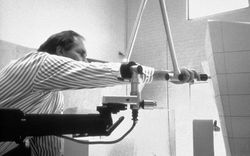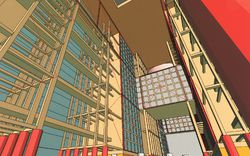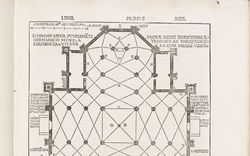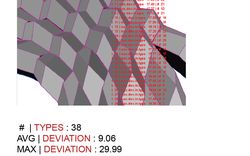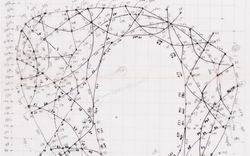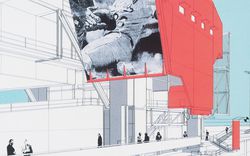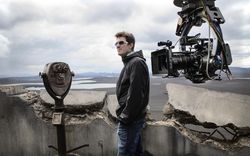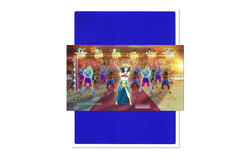Architecture’s Digital Turn and the Advent of Photoshop
Text by Amy Kulper
This research project, which I’ve only undertaken for about a year, started off with a funny story. My daughter is a fifth grader in a small progressive school in Ann Arbor called the Summers-Knoll school and it took me three years of her being there before I said, “Knoll, Knoll, Knoll…” and made the connection that Thomas Knoll, the inventor of Photoshop, was actually the founder of her school. At which point I began to wonder, “Well, where are his papers and where did he grow up and how did he become interested in photographic images?” And it turned out that the University of Michigan has all of the papers from his doctoral work in the engineering program and that, interestingly, his father was a professor in the engineering program and an avid amateur photographer— they had a darkroom in the house that they grew up in. Ann Arbor is also the producer of a camera called the Argus camera that is very much a part of the local culture. (Though they are not a household name, Argus made one of the best-selling cameras in history, the C3, also known as “the brick.”) So Knoll—the son of an avid photographer in a town where photography is very much present—himself became an avid photographer. All of this was a hidden history. I also discovered that Knoll began his work at University of Michigan while his brother, John, went out to the west coast and became one of the key people in George Lucas’ Industrial Light & Magic, the special effects arm of his company. As soon as I found out those documents were in the archive—that Knoll was there, that his brother was producing filmic effects—the story emerged.
Read more
So much of contemporary digital culture is beholden to ideas of the production of effects and yet when the brothers launched the software Adobe said, “Well, nobody’s going to be interested in effects. You know, just work on correcting photographic images and we’ll worry about the rest later.” Adobe was incredibly short-sighted in not yet seeing how much the production of effects would become a commercial entity. So the story began with the dialogue between two brothers, engaged in different operations but fuelled by a local context and interest in photography and collections—in editing and optical correction of the photographic.
Part of the argument that I want to make with this research is that we so often, in architectural discourse, think of the digital turn as being really closely associated with the parametric and the ideas of digital form-finding that it promotes. But the seeds of so-called “parametric thinking” are in Photoshop and the software is in fact already a parametric manipulation of images. What is critical is that Photoshop’s instrumentality masks itself, resulting in an essential confusion in our discipline in which we think that we’re dealing with content in Photoshop. If I’m manipulating the image of the Barcelona Pavilion, I think that I’m manipulating architectural content, when in fact what I’m manipulating is universal mathematical code. This is already a binary coded object and there are two ways that I can manipulate it. I can manipulate it as a simulation—in other words, I can manipulate it so that I keep it photo realistically as close as possible to the architectural space that I know that I’m working on—or I can manipulate it to a parametric effect. Photoshop is so closely elided with photo realistic representation that we tend not to see that this parametric capacity to completely distort the image and, in fact, generate other forms, is also nascent in the software.
This initial confusion between content—the architectural space itself—and actual information—the universal mathematical code—is really important to the question of how architects use digital tools. It is a critical move away from the object, and if you think about what’s going on right now in architectural discourse, there’s a real interest in what’s called “object-oriented ontology.” And I think that this return to the object, mostly by digital practitioners, has to do with Photoshop unwittingly moving us away from the object when we thought we were moving closer to the ‘realism’ of the object.
Because I’m coming at this from the discipline of architecture, I’m trying to focus on the implications of Photoshop in architectural design and how it influences us as designers—even though as a historian of ideas I’m always lured outside of the specific subject. So I’m looking at the protracted history of optical correction that is a part of our discourse going all the way back to Proto-Hellenic architecture and ideas about entasis—the swelling at the middle of a column—or the foreshortening of sculpture to be seen from a certain point of view. All of those are moments where optical correction entered the discipline of architecture and I position Photoshop as another tool towards that end. The difference being that Photoshop is operating on the images of architecture, not the actual spaces. I repeat that, again and again, because we lose sight of that part of its operation, which is a fascinating oversight. We think we are producing spatial effects but we are, in fact, producing pictorial effects.
Historians have a problem because we always want to find the moment—in this case, the moment when Photoshop emerged. We know the moment is 1988 but, as I’ve been to different archives and spoken to friends who were designing during this period, I’ve realized that it came to everyone at different moments. So part of my research has been in proto-digital design protocols. One of my case studies is Neil Denari—a long-time friend and colleague who hired me to teach at SCI_Arc—who said to me, “You know, I didn’t buy Photoshop at the time it came out because I couldn’t afford it.” But then he shared the procedures for making his drawings, which are completely Photoshopic, prior to the advent of the software. His practice was already anticipating the function and reception of the software. Neil would make ink base drawings which would then be reproduced PMT (photo-mechanical transfer) prints. Those would be the “originals,” which he’s never exhibited. To me, that’s already a Photoshopic tendency because it says that the original doesn’t mean anything because the software is always in the process of manipulating that thing. So, in a sense, it has no value.
Denari would then apply pantone film to the prints as a colourful “second life” to the black and white originals. He would make one sea-foam green and send it to Frankfurt, and he’d make another orange and send it to San Francisco, because he was doing shows in various places. This process of manipulating a base image through filters, like a photographic operation, was happening in his practice before he ever acquired the software. He describes it as a giant cut and paste operation. I find it fascinating that his practice was already anticipating certain kinds of features and tools within Photoshop.
All of that is to say that 1988, as much as I try to find evidence that points exactly to 1988 and what happened before and after, is much less clear as a specific moment in the case studies that I’m looking at. This is interesting with respect to the argument about whether or not this actually constitutes a digital turn. Because if practice is already anticipating the various ways in which Photoshop works—and as architects we work on trace and Mylar, so the idea of layers is not at all a new concept to design—then those practices were being developed simultaneously with the features of Photoshop. There’s a real absence on that in the literature on new media. There are people who often reference the parallels between film or musical recording, for example, but very few people mention what’s going on in architecture, despite this history of working with layers. Most people who are working on questions of new media agree that this is one of Photoshop’s most salient features but we’ve been working this way, for years and years, before the appearance of the software. These questions eschew the precise practices of the historian a little bit, because one also has to listen to the archives and the drawings if they don’t offer up what it is you think you’re looking for.
Photoshop is now part of what they call the Creative Cloud, which carries a notion of ubiquity. I had a research assistant who was tracking every appearance in daily newspapers, blogs, and so on—trying to track the cultural impact of Photoshop. And it became an overwhelming collection of things. The fact that it is so prevalent in our newspaper headlines and popular culture stories also speaks to how a specific software application has become the medium through which we operate. Now Adobe works on plug-ins and Thomas Knoll says that these plug-ins produce a “smooth handshake” with every other software. So the idea is that Photoshop essentially disappears and the operation of substituting information for content disappears with it. And the disappearance of that instrumentality seems critical to who we are as architects.
When I finished my PhD in the UK, my first teaching job was at UCLA and it was at the time that Greg Lynn was developing his ideas about the blob. I had spent my time in Cambridge studying questions of the representation of the natural in architecture and one of my key references was D’Arcy Wentworth Thompson’s On Growth and Form. In one plane ride I went from one of the most conservative institutions of architecture in the world to one of the least, and when I got there, the first thing I noticed was that all of Greg Lynn’s students had On Growth and Form on their desks. So while Greg was theorizing animate form and running his design studios, I developed a seminar on design morphology and Greg, as a digital practitioner, would join us on occasion and vivify some of the questions we were posing. Even though I’m trained as an architect, I’m not using these tools regularly and so an important part of my research is to be in constant dialogue with my colleagues who are, and to question them. Greg was the first person who was generous enough to share his insights with me.
When I started teaching at Michigan, I brought the morphology course with me and one of the exercises that I do with students is to assign them each a software and ask them to identify its biases and propensities. This is a tricky problem in the philosophy of technology. We’ve heard it said, probably a million times, that “Photoshop is just another tool, formZ is just another tool,” and I think that the difficulty is that if, as a student of design, you accept it as just another tool—like a hammer—then you’re not looking for its biases. You’re not saying, “Well, there are some underlying issues here that I have to address.”
I think that Greg, in an early interview when he was doing the blob forms, said that his design was 51% Maya. That idea really stuck, because it wasn’t clear to me that the students of design that I was engaging with understood that the software was 51% of the design. And so this exercise of unpacking the biases of software—that formZ works through extrusion or that Maya is a surface modeller and not so good at interior construction—leads to a conclusion from Lev Manovich—somebody who’s thinking certainly influenced my research—that, “Software is media. Software is the media.” So Photoshop is media, and I don’t think we think about it that way yet. We still think in such traditional categories of media as, “Is it a drawing? Is it a model? Is it a…” As somebody who both teaches history and theory as well as design, I’m really interested in uncoupling questions of software and media to produce some clarity.
There’s no question whether we call it a digital turn or not, whether this is the direction in which architecture’s going. It seems to me that that’s an inevitability, and given that, how do we as educators posit that clearly to our students so that they’re aware of the tools that they’re using and what they bring to the table—aware that each tool has its own logics and tendencies, and is not just another tool.
During a lecture at the CCA in June, 2016, Amy Kulper locates architecture’s “digital turn” in 1988, when Thomas Knoll invented Photoshop. The lecture was presented in conjunction with the exhibition Archaeology of the Digital: Complexity and Convention.
